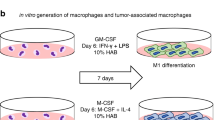Abstract
Tumor-associated macrophages (TAMs) are one of most important components of the tumor microenvironment. Although many assays have been developed to differentiate monocytes into macrophages (Mϕ) for studying the biology of TAMs in vitro, little is known whether the macrophages induced by these approaches can recapitulate the biology of TAMs present in the tumor microenvironment. We have developed a novel assay to differentiate human monocytes into TAMs using modified melanoma-conditioned medium, which is derived from the concentrated tumor cell culture medium. Characterization of these modified melanoma-conditioned medium-induced macrophages (MCMI-Mϕ) by multiple flow cytometry, Luminex, microarray, and immunohistochemistry analyses indicates that MCMI-Mϕ are phenotypically and functionally highly similar to the TAMs present in the tumor microenvironment.
Access this chapter
Tax calculation will be finalised at checkout
Purchases are for personal use only
Similar content being viewed by others
References
Biswas SK, Mantovani A (2010) Macrophage plasticity and interaction with lymphocyte subsets: cancer as a paradigm. Nat Immunol 11(10):889–896. https://doi.org/10.1038/ni.1937
Cassetta L, Fragkogianni S, Sims AH, Swierczak A, Forrester LM, Zhang H, Soong DYH, Cotechini T, Anur P, Lin EY, Fidanza A, Lopez-Yrigoyen M, Millar MR, Urman A, Ai Z, Spellman PT, Hwang ES, Dixon JM, Wiechmann L, Coussens LM, Smith HO, Pollard JW (2019) Human tumor-associated macrophage and monocyte transcriptional landscapes reveal cancer-specific reprogramming, biomarkers, and therapeutic targets. Cancer Cell 35(4):588–602 e510. https://doi.org/10.1016/j.ccell.2019.02.009
DeNardo DG, Ruffell B (2019) Macrophages as regulators of tumour immunity and immunotherapy. Nat Rev Immunol 19(6):369–382. https://doi.org/10.1038/s41577-019-0127-6
Komohara Y, Jinushi M, Takeya M (2014) Clinical significance of macrophage heterogeneity in human malignant tumors. Cancer Sci 105(1):1–8. https://doi.org/10.1111/cas.12314
Pollard JW (2004) Tumour-educated macrophages promote tumour progression and metastasis. Nat Rev Cancer 4(1):71–78. https://doi.org/10.1038/nrc1256
Kumar S, Ramesh A, Kulkarni A (2020) Targeting macrophages: a novel avenue for cancer drug discovery. Expert Opin Drug Discov 15(5):561–574. https://doi.org/10.1080/17460441.2020.1733525
Ruffell B, Coussens LM (2015) Macrophages and therapeutic resistance in cancer. Cancer Cell 27(4):462–472. https://doi.org/10.1016/j.ccell.2015.02.015
Benner B, Scarberry L, Suarez-Kelly LP, Duggan MC, Campbell AR, Smith E, Lapurga G, Jiang K, Butchar JP, Tridandapani S, Howard JH, Baiocchi RA, Mace TA, Carson WE 3rd (2019) Generation of monocyte-derived tumor-associated macrophages using tumor-conditioned media provides a novel method to study tumor-associated macrophages in vitro. J Immunother Cancer 7(1):140. https://doi.org/10.1186/s40425-019-0622-0
Heideveld E, Horcas-Lopez M, Lopez-Yrigoyen M, Forrester LM, Cassetta L, Pollard JW (2020) Methods for macrophage differentiation and in vitro generation of human tumor associated-like macrophages. Methods Enzymol 632:113–131. https://doi.org/10.1016/bs.mie.2019.10.005
Wang T, Ge Y, Xiao M, Lopez-Coral A, Azuma R, Somasundaram R, Zhang G, Wei Z, Xu X, Rauscher FJ 3rd, Herlyn M, Kaufman RE (2012) Melanoma-derived conditioned media efficiently induce the differentiation of monocytes to macrophages that display a highly invasive gene signature. Pigment Cell Melanoma Res 25(4):493–505. https://doi.org/10.1111/j.1755-148X.2012.01005.x
Wang T, Xiao M, Ge Y, Krepler C, Belser E, Lopez-Coral A, Xu X, Zhang G, Azuma R, Liu Q, Liu R, Li L, Amaravadi RK, Xu W, Karakousis G, Gangadhar TC, Schuchter LM, Lieu M, Khare S, Halloran MB, Herlyn M, Kaufman RE (2015) BRAF inhibition stimulates melanoma-associated macrophages to drive tumor growth. Clin Cancer Res 21(7):1652–1664. https://doi.org/10.1158/1078-0432.CCR-14-1554
Drexler HG, Uphoff CC (2002) Mycoplasma contamination of cell cultures: incidence, sources, effects, detection, elimination, prevention. Cytotechnology 39(2):75–90. https://doi.org/10.1023/A:1022913015916
Stacey A, Doyle A (1997) Routine testing of cell cultures and their products for mycoplasma contamination. Methods Mol Biol 75:305–311. https://doi.org/10.1385/0-89603-441-0:305
Baust JM, Buehring GC, Campbell L, Elmore E, Harbell JW, Nims RW, Price P, Reid YA, Simione F (2017) Best practices in cell culture: an overview. In Vitro Cell Dev Biol Anim 53(8):669–672. https://doi.org/10.1007/s11626-017-0177-7
Phelan K, May KM (2015) Basic techniques in mammalian cell tissue culture. Curr Protoc Cell Biol 66:1 1 1–1 1 22. https://doi.org/10.1002/0471143030.cb0101s66
Phelan K, May KM (2016) Basic techniques in mammalian cell tissue culture. Curr Protoc Toxicol 70:A 3B 1-A 3B 22. https://doi.org/10.1002/cptx.13
Cabrera CM, Cobo F, Nieto A, Cortes JL, Montes RM, Catalina P, Concha A (2006) Identity tests: determination of cell line cross-contamination. Cytotechnology 51(2):45–50. https://doi.org/10.1007/s10616-006-9013-8
Dirks WG, MacLeod RA, Nakamura Y, Kohara A, Reid Y, Milch H, Drexler HG, Mizusawa H (2010) Cell line cross-contamination initiative: an interactive reference database of STR profiles covering common cancer cell lines. Int J Cancer 126(1):303–304. https://doi.org/10.1002/ijc.24999
Geraghty RJ, Capes-Davis A, Davis JM, Downward J, Freshney RI, Knezevic I, Lovell-Badge R, Masters JR, Meredith J, Stacey GN, Thraves P, Vias M, Cancer Research UK (2014) Guidelines for the use of cell lines in biomedical research. Br J Cancer 111(6):1021–1046. https://doi.org/10.1038/bjc.2014.166
Faradji A, Bohbot A, Schmitt-Goguel M, Siffert JC, Dumont S, Wiesel ML, Piemont Y, Eischen A, Bergerat JP, Bartholeyns J et al (1994) Large scale isolation of human blood monocytes by continuous flow centrifugation leukapheresis and counterflow centrifugation elutriation for adoptive cellular immunotherapy in cancer patients. J Immunol Methods 174(1–2):297–309. https://doi.org/10.1016/0022-1759(94)90033-7
Clarke EV, Benoit ME, Tenner AJ (2013) Purification of human monocytes and lymphocyte populations by counter current elutriation- a short protocol. Bio Protoc 3(23):e981. https://doi.org/10.21769/bioprotoc.981
Acknowledgments
We thank Dr. Meenhard Herlyn from the Wistar Institute and Gerald M. Feldman from the FDA for the intellectual and technical support for the development of this protocol.
Disclaimer: The views in this chapter have not been formally disseminated by the U.S. Food and Drug Administration and should not be construed to represent any agency determination or policy.
Author information
Authors and Affiliations
Corresponding author
Editor information
Editors and Affiliations
Rights and permissions
Copyright information
© 2021 Springer Science+Business Media, LLC, part of Springer Nature
About this protocol
Cite this protocol
Wang, T., Kaufman, R.E. (2021). In Vitro Differentiation of Tumor-Associated Macrophages from Monocyte Precursors with Modified Melanoma-Conditioned Medium. In: Hargadon, K.M. (eds) Melanoma. Methods in Molecular Biology, vol 2265. Humana, New York, NY. https://doi.org/10.1007/978-1-0716-1205-7_9
Download citation
DOI: https://doi.org/10.1007/978-1-0716-1205-7_9
Published:
Publisher Name: Humana, New York, NY
Print ISBN: 978-1-0716-1204-0
Online ISBN: 978-1-0716-1205-7
eBook Packages: Springer Protocols




